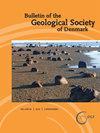A tale from the middle Paleocene of Denmark: A tube-dwelling predator documented by the ichnofossil Lepidenteron mortenseni n. isp. and its predominant prey, Bobbitichthys n. gen. rosenkrantzi (Macroridae, Teleostei)
IF 1
4区 地球科学
Q2 Earth and Planetary Sciences
引用次数: 5
Abstract
The ichnofossil Lepidenteron provides a unique taphonomic window into the life habits of a tube-dwelling predator, probably an eunicid polychaete, and its fish prey. Here we describe a new tube-like ichnofossil Lepidenteron mortenseni n. isp. from the Kerteminde Marl (100–150 m palaeo-water depth) from the Gundstrup gravel pit near Odense, Fyn, Denmark. 110 individual tubes were examined which contain fish remains, including a variety of disarticulated bones and otoliths, by far dominated by a single gadiform taxon referred herein to as Bobbitichthys n. gen. The isolated otoliths here associated with disarticulated gadiform bones have previously been described, from the time equivalent Lellinge Greensand exposed in the Copenhagen area, as Hymenocephalus rosenkrantzi, a grenadier fish (family Macrouridae). The abundance of associated bones and otoliths in the examined tubes allowed us to reconstruct part of the cranial configuration of Bobbitichthys rosenkrantzi and to tentatively interpret it as a stem macrourid. Bobbitichthys rosenkrantzi represents the earliest grenadier known in the fossil record. Additional, although considerably less abundant, skeletal remains and otoliths have been tentatively referred to a long-fin bonefish (family Pterothrissidae, Pterothrissus? conchaeformis), a viviparous brotula (family Bythitidae, Bidenichthys? lapierrei), a conger eel (family Congridae, possibly belonging to Rhynchoconger angulosus), and another unidentified gadiform.丹麦古新世中期的一个故事:一种管栖食肉动物,由遗迹化石Lepidentieron mortenseni n.isp记录。以及它的主要猎物,Bobbitichthys n.gen.rosenkrantzi(Macroridae,Teleostei)
Lepidentieron遗迹化石为了解管栖食肉动物(可能是真科多毛类)及其鱼类猎物的生活习惯提供了一个独特的解剖学窗口。在这里,我们描述了一种新的管状遗迹化石Lepidentieron mortenseni n.isp。来自丹麦Fyn Odense附近Gundstrup砾石坑的Kerteminde Marl(古水深100-150 m)。检查了110个单独的管,其中包含鱼类遗骸,包括各种断开关节的骨头和耳石,迄今为止,由一个单一的gadiform分类单元(本文称为Bobbitichthys n.gen.)主导。这里与断开关节gadiform骨头相关的孤立耳石先前已被描述,来自暴露在哥本哈根地区的时间等效的Lellinge Greensand,称为膜片鱼,是一种掷弹鱼(Macrouridae科)。在检查的管道中,丰富的相关骨骼和耳石使我们能够重建罗森克兰茨博比特鱼的部分颅骨结构,并初步将其解释为大型茎鱼。罗森克兰茨博比特鱼代表了化石记录中已知的最早的掷弹兵。此外,尽管数量少得多,但骨骼遗骸和耳石已被初步认为是一种长鳍带骨鱼(Pterothrisidae,Pterothrissus?contraeformis)、一种胎生布鲁瓦鱼(Bythitidae,Bidenichthys?lapierrei)、一条同类鳗鱼(Congidae,可能属于Rhynchoconger angulosus)和另一种未经确认的gadiform。
本文章由计算机程序翻译,如有差异,请以英文原文为准。
求助全文
约1分钟内获得全文
求助全文
来源期刊

Bulletin of the Geological Society of Denmark
GEOSCIENCES, MULTIDISCIPLINARY-
CiteScore
2.80
自引率
16.70%
发文量
28
审稿时长
>12 weeks
期刊介绍:
The Bulletin publishes contributions of international interest in all fields of geological sciences on results of new work on material from Denmark, the Faroes and Greenland. Contributions based on other material may also be submitted to the Bulletin if the subject is of relevance for the geology of the area of primary interest.
 求助内容:
求助内容: 应助结果提醒方式:
应助结果提醒方式:


